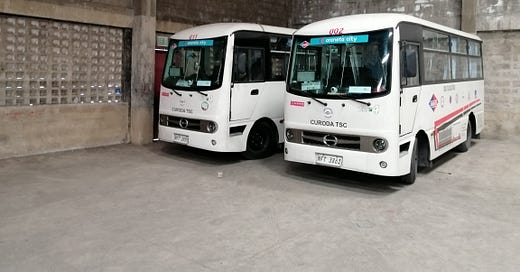How jeepneys can help beat big business
With gov't support, jeepney drivers can make the transition to modernization
These modern jeeps await deployment in a Pasig City garage in a photograph taken in 2021.
Ten days before Christmas, critics of a Philippine transport plan weren't exactly brimming with good cheer.
During a December 15 press conference, they warned that big business was poised to take over the livelihoods of struggling jeepney drivers if the plan to modernize public transport pushed through.
The possibility was raised earlier this year by a paper produced by the University of the Philippines Center for Integrative Development Studies and co-written by members of two groups opposed to the jeepney modernization program. [See: UP CIDS]
The admittedly costly and complicated plan to make jeepneys friendlier to commuters and the environment will leave thousands of drivers and their families destitute, critics said.
Thankfully, that scenario has yet to fully play out.
Although a business tycoon has already allotted more than a billion pesos to replace antiquated smoke belchers with electric vehicles, that move may still be completed later than sooner. [See: MVP]
But then again, it also doesn't exactly mean that drivers and owners of traditional jeepneys — including vehicles older than members of Gen Z — are powerless over their collective existential threat.
After all, they can still choose to put up cooperatives as indicated in the Public Utility Vehicle Modernization Program (PUVMP).
Once completed, the newly-minted jeepney cooperative — and no one else — will enjoy the exclusive right to pick up and drop off passengers on the same route they all served before consolidation.
In a 2021 interview, Ramil Padrigo, a former Philippine Navy officer who served as a United Nations peacekeeper in East Timor in the 1990s, said that he sold his traditional jeep to comply with the government’s modernization program. He is one of the leaders of the Cubao-Rosario-Sta. Lucia Transport Service Cooperative.
In short, as members of one cooperative, they will no longer A), compete for the same set of passengers; and B), struggle to meet their daily rent (more popularly known as boundary).
Besides hopefully curbing their bad driving habits, this improvement is also expected to pave the way for the introduction of scheduled stops on certain locations, just like mass transit systems in more advanced economies. These scheduled stops, in turn, are expected to make us more punctual and perhaps wean us away from the concept of Filipino time.
With proper guidance and support, these cooperatives would arguably be financially strong enough to take out loans for modern vehicles and pay salaries and offer benefits to its member-workers.
In the future, these transport cooperatives can form its own industry association, launch their own party-list group, and become a potent force for change, inside and outside the transport sector.
However, that's all a pipe dream at the moment.
As recent experience has shown, establishing and managing a jeepney cooperative aren’t easy.
The task was made more difficult by the COVID-19 pandemic, when very few persons were allowed to go out, let alone take public transport.
In 2021, when mobility restrictions were eased, the free bus trips offered by government often cut into the same routes that jeepney cooperatives served, further causing them to lose passengers and incomes.
As a result, the cooperatives — which, it must be emphasized, complied with the modernization program years before its deadline — had to deal with competition that was not contemplated under the modernization program. It also didn’t help that independent and illegal jeepney drivers continued to ply their routes during the lockdowns.
Despite these challenges, jeepney consolidation and modernization can still be done.
Recently, cooperatives in Batangas, Cebu, and Metro Manila have even managed to expand their fleets, with some help from government subsidies which, by the way, also need to be increased. [See: Batangas, Cebu]
Other jeepney drivers and operators have begun to follow their lead, however slowly.
As of February this year, 60% of the total 185,000 jeepneys in the country have already adopted the modernization program, a report by Japan Times said, citing government figures. [See: Japan Times]
In the meantime, if no jeepney cooperative is established for a route, only then will the private sector be allowed to take it over.
Which is what exactly happened in Iloilo City in 2018. And it only became possible because the route was new. (The said route, which connects the city center to a mall in the outskirts, is being served by a business group which also owns the same mall.)
Arguably, jeepney drivers have been given enough time to consolidate. They have until the end of the year to form a cooperative or join one; a deadline that's been postponed seven times ever since it was first deferred in early 2020 due to the pandemic.
But instead of getting with the program, groups such as PISTON (Pagkakaisa ng mga Samahan ng Tsuper at Opereytor Nationwide) have chosen to launch a transport strike.
Representatives of anti-jeepney modernization groups, led by the Philippine Movement for Climate Justice and Pagkakaisa ng mga Samahan ng Tsuper at Opereytor Nationwide, among others, pose for a photo during a December 15 press conference in Quezon City. (PMCJ)
Besides rejecting modernization, they are also opposing moves of big business to take over the public transport sector.
The National Confederation of Transport Unions (NCTU) has a different take.
"To resist the takeover of big business, they should all the more push for and support consolidation and modernization," said an official of the union, which provides assistance to drivers and operators to put up a transport cooperative. "What we should all do now is to advocate for bigger budgets and subsidies that will help transport cooperatives."






